coolant temperature GMC JIMMY 1997 Owner's Manual
[x] Cancel search | Manufacturer: GMC, Model Year: 1997, Model line: JIMMY, Model: GMC JIMMY 1997Pages: 410, PDF Size: 20.03 MB
Page 78 of 410
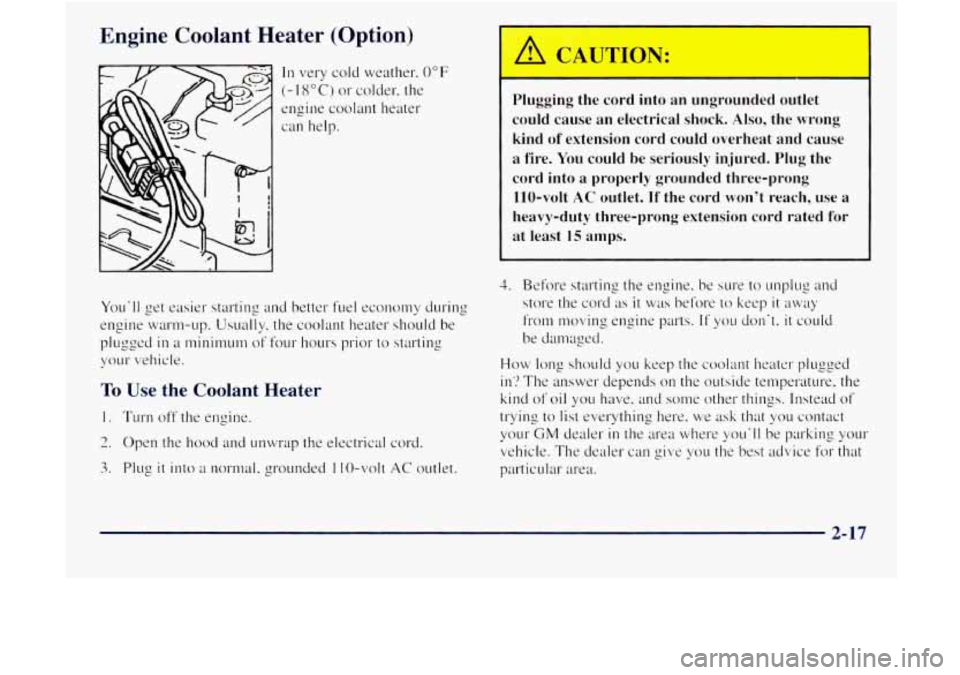
Engine Coolant Heater (Option)
In very cold weather. 0°F
(- 18°C) or colcfer. the
engine coolant heater
can help. Plugging the cord into an ungrounded outlet
could cause an electrical shock. Also, the wrong
kind
of extension cord could overheat and cause
a fire. You could be seriously injured. Plug the
cord into
a properly grounded three-prong
110-volt
AC outlet. If the cord won't reach, use
heavy-duty three-prong extension cord rated for
at least
15 amps.
You'll get easier starting and better file1 economy during
engine wa1-tm-up. Usually, the coolant heater should be
plugged
in a tnini~num of four hours prior to starting
your vehicle.
To Use the Coolant Heater
1. Turn off the engine.
2. Open the hood and unwrap the electrical cord.
3. Pl~lg it into a nol-r.nal, grounded 1 IO-volt AC outlet.
4. Before starting the engine. be s~11-e to unplug and
store the cord as it was before to keep it away
from moving engine parts. If you clon't. it could
be da111~1ged.
How long should you keep the coolant heater plugged
in? The answer depends on the outside temperature. the
kind
of oil you have, and solne other things. Instead of
trying to list everything here. we ask that ~OLI contact
yoc~r
GM dealer in the area where you'll be parking your
vehicle. The dealer can gi\:e you the best advice for that
particular area.
2-17
Page 137 of 410
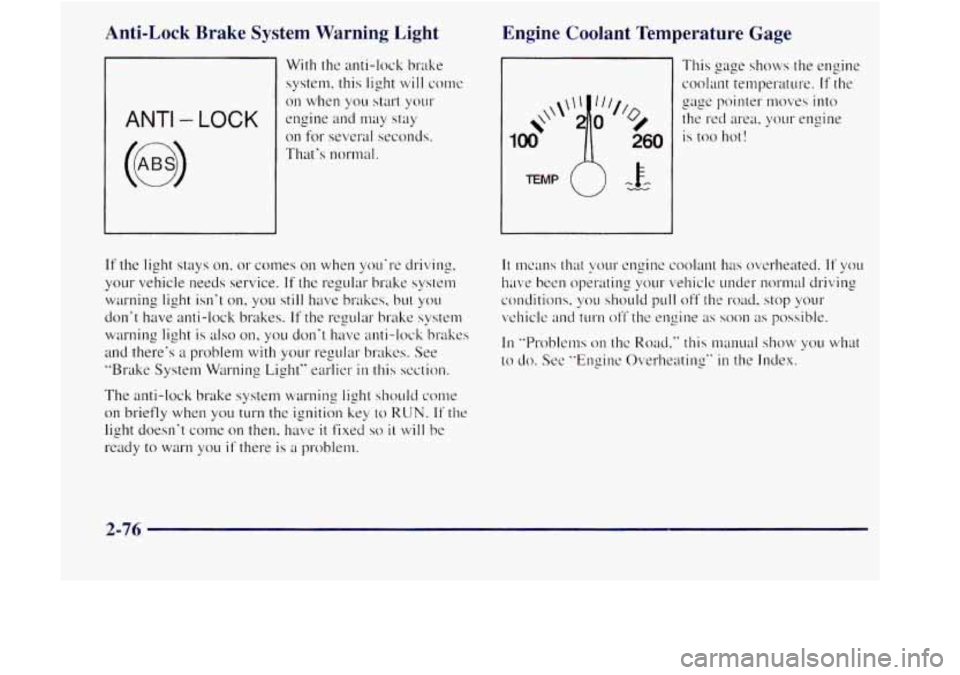
Anti-Lock Brake System Warning Light
With the anti-lock brake
system. this light
will CC)IIIC
engine and may stay
on for several seconds.
That's normal.
011 when you start y0LIr
Engine Coolant Temperature Gage
2-76
Page 146 of 410
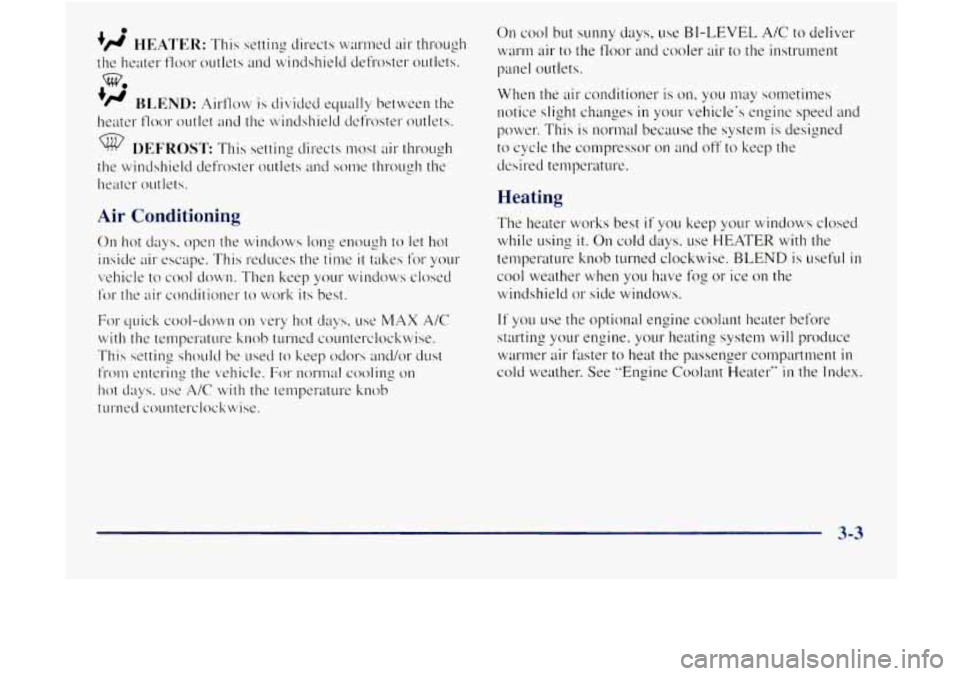
Air Conditioning
011 cool but sunny days, use BI-LEVEL A/C to deliver
~varm
air to the floor and cooler air to the instrument
p"nel outlets.
When the air conditioner is on. you may sometimes
notice slight changes
in your 1:ehicle's engine speed and
power, This
is normal because the system is designed
to cycle the compressor
on and off to keep the
clesired temperature.
Heating
The heater works best if yo11 keep plr windows closed
while using
it. On cold days. use HEATER With the
ten~perature knob turned clockwise.
BLEND is LISS~LI~ in
cool weather when you have fos or ice on the
winclshield
or side windows.
If ~OLI use the optional engine coolant heater befhre
starting yo~~r engine. your heatin2 system will produce
warmer air faster to heat the passenger compartment
in
cold weather. See "Engine Coolant Heater" in the Index.
3-3
Page 217 of 410
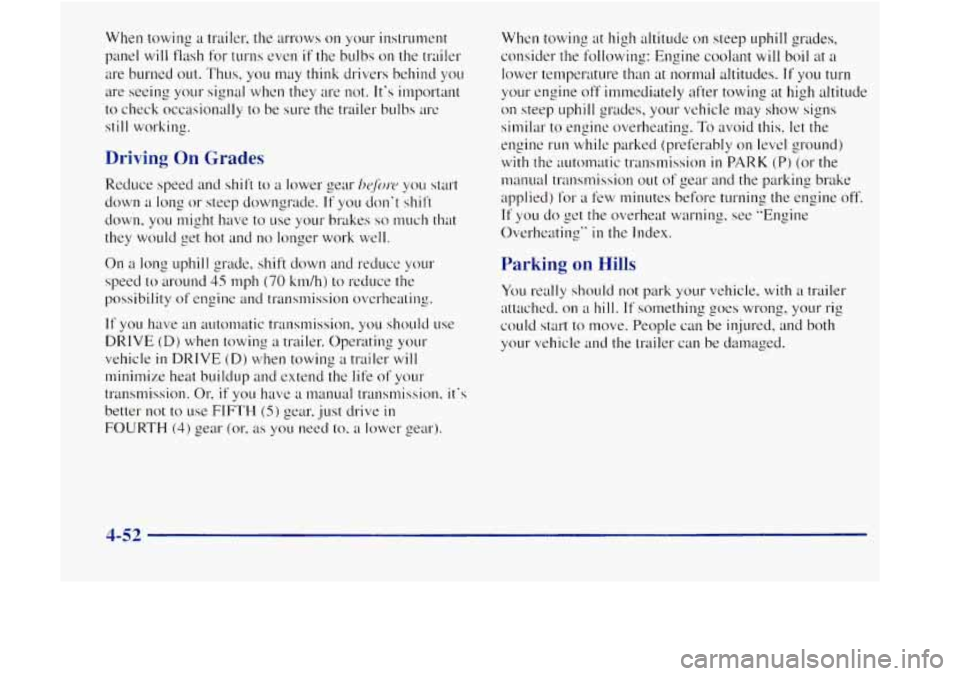
When towing a trailer, the ~~rrows on your instrument
panel
will flash for turns even if the bulbs on the trailer
itre burned out. Thus. you may think drivers behind you
are seeing your signal when they are not. It's important
to check occasionally to be sure the trailer bulbs arc
still working.
Driving On Grades
On a long uphill grade, shift down and reducc your
speed
to around 45 mph (70 km/h) to reduce the
possibility
of engine and transmission ovc.rheating.
If you have an automatic transmission. you should use
DRIVE
(D) when towing a trailer. Operating your
vehicle
in DRIVE (D) when towing a trailer will
minimize heat buildup and extend the life
of your
trrmsmission. Or:
if you have ;1 manual transmission. it's
better not to use FIFTH (5) gear. just drive in
FOURTH (4) gear (or, as you need to, a I~MW gear). Whcn
towins at high altitude
on steep uphill grades,
consider the following: Engine coolant will boil at a
lower temperature than at normal altitudes. If yo^^ turn
your engine off immediately after towing
at high altitude
on steep uphill grades, your \:ellicle may show signs
similar to engine overheating.
To avoid this. let the
engine
r~~n while parked (preferably on level grout1d)
with the automatic transmission in PARK (Pj (or the
1manuaI transmission out of
gear and the parking brake
applied) 1'01-
;I few minutes before turning the engine off.
If you do get the overheat warning. see "Engine
Overheating"
in the Index.
Parking on Hills
You really should not park your vehicle. with a trailer
attached.
on a hill. If something goes wrong, your rig
could start
to move. People can be injured, and both
yo~~r vehicle and the trailer can
be damaged.
4-52
Page 233 of 410
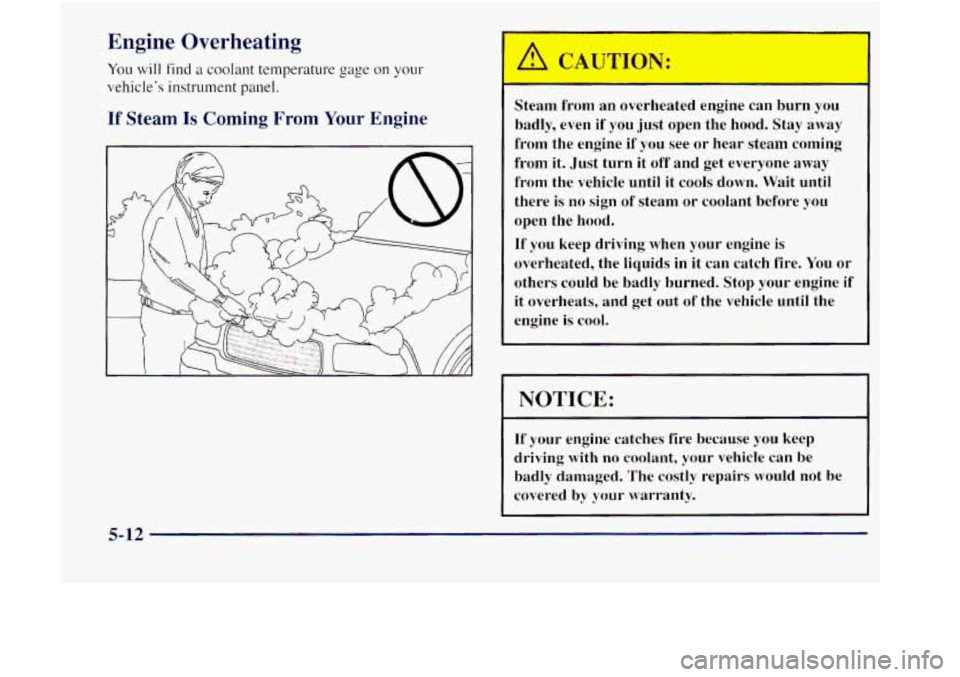
Engine Overheating
You will find a coolant temperature gage on your
vehicle's instrument panel.
If Steam Is C . - g I; - ___I Your Engine
Steam from an overheated engine can burn you
badly, even if you just open the hood. Stay away
from the engine
if you see or hear steam coming
from it. Just turn it off and get everyone
away
from the vehicle until it cools down. Wait until
there
is no sign of steam or coolant before you
open the hood.
If you keep driving when your engine is
overheated, the liquids in it can catch fire,
You or
others could be badly burned.
Stop your engine if
it overheats, and get out of the vehicle until the
engine
is cool.
NOTICE:
If your engine catches fire because you keep
driving with no coolant, your vehicle can
be
badly damaged. The costly repairs would not be
covered by your warranty.
5-12
Page 282 of 410
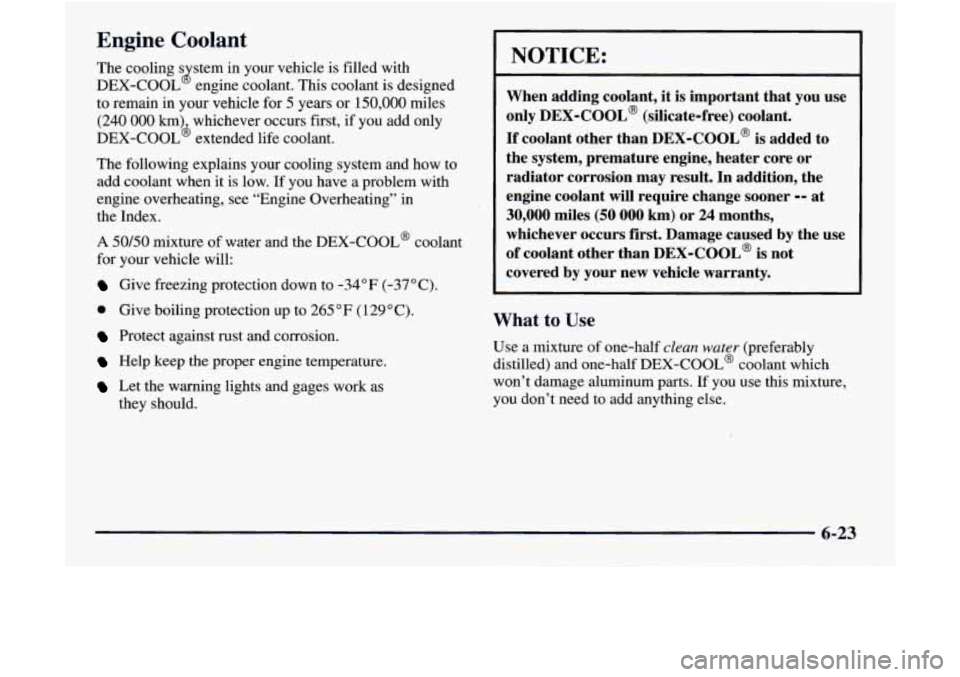
Engine Coolant
The cooling s stem in your vehicle is filled with
DEX-COOL engine coolant. This coolant is designed
to remain in your vehicle
for 5 years or 150,000 miles
(240 000 km) whichever occurs first, if you add only
DEX-COOL’ extended life coolant.
The following explains your cooling system and how to
add coolant when it is low. If you have a problem with
engine overheating, see “Engine Overheating” in
the Index.
A 50/50 mixture of water and the DEX-COOL@ coolant
for your vehicle will:
Give freezing protection down to -34°F (-37°C).
0 Give boiling protection up to 265 OF ( 129 O C).
Protect against rust and corrosion.
Help keep the proper engine temperature.
Let the warning lights and gages work as
8
they should.
NOTICE:
When .adding coolant, it is important that you use
only
DEX-COOL@ (silicate-free) coolant.
If coolant other than DEX-COOL@ is added to
the system, premature engine, heater core
or
radiator corrosion may result. In addition, the
engine coolant will require change sooner
-- at
30,000 miles (50 000 km) or 24 months,
whichever occurs
first. Damage caused by the use
of coolant other than DEX-COOL@ is not
covered by your new vehicle warranty.
What to Use
Use a mixture of one-half clean water (preferably
distilled) and one-half DEX-COOL@ coolant which
won’t damage aluminum parts. If you use this mixture,
you don’t need to add anything else.
6-23
Page 285 of 410
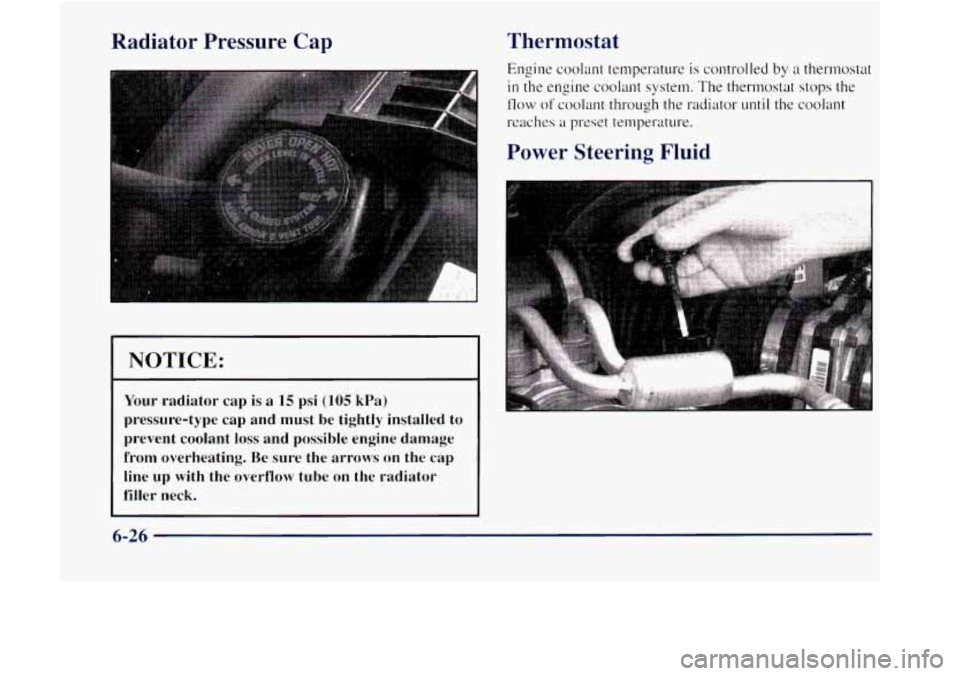
Radiator Pressure Cap
NOTICE:
Your radiator cap is a 15 psi (105 kPa)
pressure-type cap and must be tightly installed to
prevent coolant
loss and possible engine damage
fronl overheating. Be sure the arrows
on the cap
line up with the overflow tube on the radiator
filler neck.
Thermostat
Engine coolant temperattrre is controlled by a thermostat
in the engine coolant system. The thermostat stops the
flow of coolant through the radiator until the coolant
reaches
a preset temperature.
Power Steerinp Fluid
6-26
Page 397 of 410
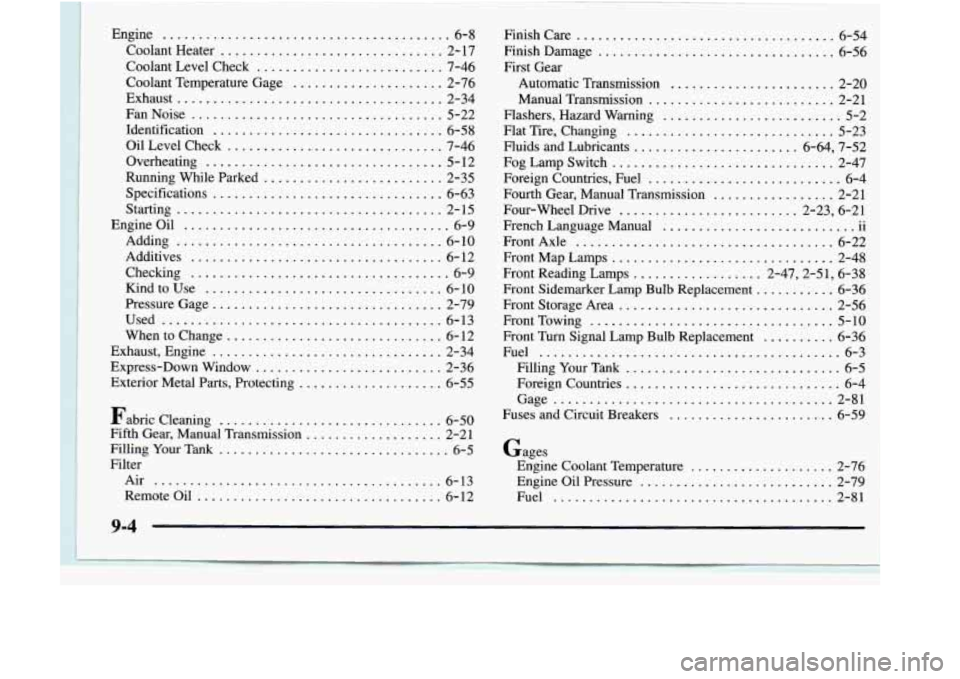
Engine ........................................ 6-8
Coolant Heater
............................... 2-17
Coolant Level Check
.......................... 7-46
Coolant Temperature Gage
..................... 2-76
Fan Noise
................................... 5-22
Exhaust
..................................... 2-34
Identification
................................ 6-58
OilLevelCheck
............................... 7-46
Overheating
................................. 5-12
Specifications
................................ 6-63
Running While Parked
......................... 2-35
Starting
..................................... 2-15
Engine Oil
..................................... 6-9
Additives
................................... 6- 12
Checlung
.................................... 6-9
Pressure Gage
................................ 2-79
When to Change
.............................. 6-12
Express-Down Window
.......................... 2-36
Exterior Metal Parts, Protecting
.................... 6-55
Adding
..................................... 6-10
Kindtouse
................................. 6-10
Used
....................................... 6-13
Exhaust, Engine
................................ 2-34
Fabric Cleaning
............................... 6-50
Fifth Gear, Manual Transmission
................... 2-21
FillingYourTank
................................ 6-5
Filter
Air ........................................ 6-13
Remote Oil
.................................. 6-12 Finishcare
. ............................i...... 6-54
First Gear Finish Damage
................................. 6-56
Automatic Transmission
....................... 2-20
Flashers, Hazard Warning
......................... 5-2
Flat Tire, Changing
............................. 5-23
Fluids and Lubricants
....................... 6-64, 7-52
Fog Lamp Switch ............................... 2-47
Foreign Countries, Fuel
........................... 6-4
Fourth Gear, Manual Transmission
................. 2-21
Four-wheel Drive
......................... 2-23, 6-21
Front Map Lamps
............................... 2-48
Front Reading
Lamps .................. 2-47,2-51, 6-38
Front Sidemarker Lamp Bulb Replacement
........... 6-36
FrontStorageArea
.............................. 2-56
ManualTransmission
.......................... 2-21
French Language Manual
u
FrontAxle .................................... 6-22
.. ...........................
FrontTowing .................................. 5-10
Front Turn Signal Lamp Bulb Replacement
.......... 6-36
Fuel
.......................................... 6-3
Filling Your
Tank .............................. 6-5
Foreign Countries
.............................. 6-4
Fuses and Circuit Breakers
....................... 6-59
Gage
....................................... 2-81
bages Engine Coolant TemDerature
.................... 2-76 v L
Engine Oil Pressure ........................... 2-79
Fuel
....................................... 2-81
9-4 b